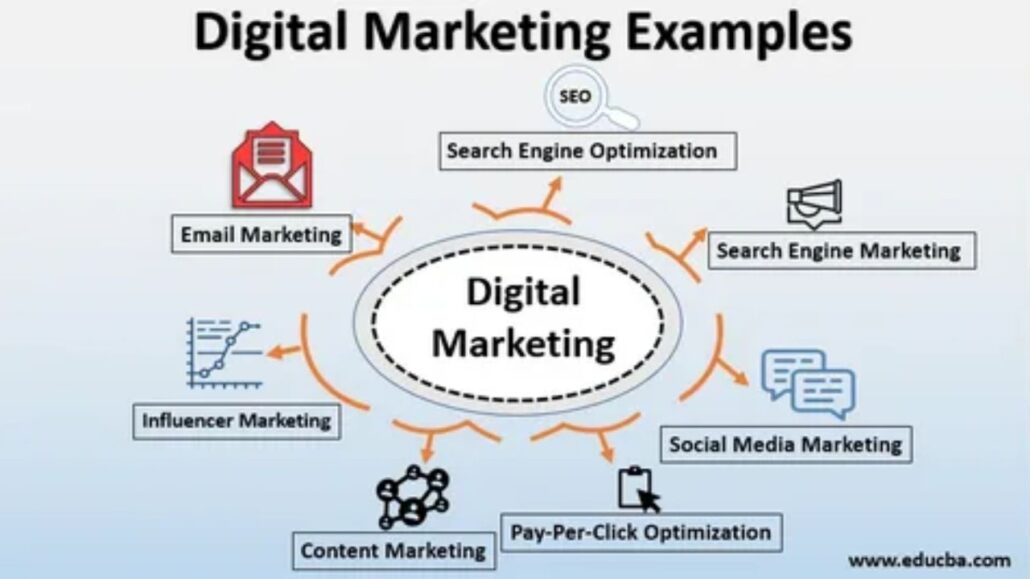In today’s rapidly evolving digital landscape, understanding the nuances between marketing and digital marketing is essential for businesses striving to stay ahead.
This article delves into the fundamental disparities between these approaches, highlighting their unique aspects, strategies, and shared elements. By grasping the intricacies of marketing and digital marketing, businesses can make informed decisions to enhance their marketing strategies effectively.
Brief Explanation of The Topic
Emarketing and digital marketing are often used interchangeably but have distinct characteristics. Emarketing primarily focuses on traditional online marketing methods, whereas digital marketing encompasses a broader range of online and offline strategies.
Importance And Relevance of The Difference
In today’s digital age, businesses rely heavily on online marketing. Understanding the differences between marketing and digital marketing is crucial for crafting targeted, effective marketing campaigns and maximizing their impact.
Key Differences: Emarketing vs. Digital Marketing
Let’s detail the differences between Emarketing and digital marketing, highlighting their unique attributes.
Scope and Channels
Emarketing predominantly revolves around email marketing and online communication platforms, whereas digital marketing spans a wider array of channels, including social media, search engines, mobile apps, and websites.
Target Audience
Emarketing often targets specific audience segments through personalized email campaigns, while digital marketing employs diverse strategies to engage a broader audience across various platforms.
Interactivity and Engagement
Emarketing relies heavily on personalized interactions through emails, fostering one-on-one communication. Digital marketing, on the other hand, emphasizes interactive content, such as videos, polls, and social media posts, to engage users effectively.
Tracking and Analytics
Digital marketing offers robust analytics tools, allowing marketers to track user behaviour, measure campaign performance, and make data-driven decisions. Emarketing may not offer the same depth of insights while providing some analytical data.
Defining Emarketing
Explanation of Emarketing and Its Components
Emarketing, short for electronic marketing, includes all marketing efforts that use the Internet or an electronic device. It encompasses email marketing, social media marketing, and online advertising, among other strategies.
Emphasis on Its Traditional Approach
Emarketing’s traditional approach involves email newsletters, online advertisements, and promotional activities on social media platforms.
Key Strategies and Tactics Used in Emarketing
Emarketing relies on email campaigns, social media promotions, and search engine optimization to engage target audiences effectively.
Defining Digital Marketing
Explanation of Digital Marketing and Its Components
Digital marketing encompasses a broader spectrum, integrating online and offline marketing efforts. It includes website optimization, mobile marketing, social media, and television advertisements.
Focus on Its Modern and Evolving Nature
Digital marketing continually evolves, adapting to new technologies and consumer behaviours. It emphasizes real-time engagement and personalized interactions.
Key Strategies and Tactics Used in Digital Marketing
Digital marketing strategies include content marketing, influencer collaborations, social media advertising, and data analytics, enabling businesses to connect with their audience more personally.
Examples of E-Marketing And Digital Marketing
E-marketing and digital marketing are umbrella terms that encompass various online marketing strategies and techniques to promote products or services online. Both methods leverage digital channels to connect with a target audience, build brand awareness, drive website traffic, and increase sales. These approaches have gained immense popularity in the modern business landscape due to the widespread use of the Internet and digital devices.
Examples of E-Marketing
Email Marketing: sending targeted promotional emails or newsletters to subscribers. Businesses can personalize content and offers based on user preferences, increasing engagement and conversion rates.
Social Media Marketing: Utilizing social media platforms like Facebook, Instagram, Twitter, and LinkedIn to reach potential customers, businesses create compelling content, run ads, and engage with their audience to build a loyal customer base.
Content Marketing: Creating and distributing valuable, relevant, consistent content, such as blogs, videos, podcasts, and infographics. Content marketing aims to attract and engage a specific audience, ultimately driving profitable customer action.
Affiliate Marketing: Partnering with affiliates who promote products or services on their platforms in exchange for a commission for every sale made through their referral. This method leverages existing online networks to expand reach.
Search Engine Marketing (SEM): Paid advertising on search engines like Google or Bing. Businesses bid on keywords related to their offerings, and their ads appear at the top of search engine results pages (SERPs) when users search for those keywords.
Examples of Digital Marketing

Search Engine Optimization (SEO): Optimizing websie content and structure to improve organic (non-paid) search engine rankings. SEO techniques enhance visibility, leading to increased website traffic and credibility.
Pay-Per-Click (PPC): running paid advertisements on search engines or other platforms. Advertisers pay a fee each time their ad is clicked. PPC campaigns can be highly targeted, ensuring ads reach a specific demographic.
Mobile Marketing: Targeting users on smartphones and tablets through mobile apps, SMS marketing, or responsive website designs. Mobile marketing capitalizes on the widespread use of mobile devices, tailoring campaigns for a mobile audience.
Display Advertising: Placing banner ads, video ads, or interactive media on third-party websites or social media platforms. These ads aim to capture the audience’s attention and redirect them to the advertiser’s website or landing page.
Influencer Marketing: involves collaborating with influencers or industry experts to promote products or services. Influencers have a dedicated following, and their endorsements can significantly impact their audience’s purchasing decisions.
Overlapping Aspects
Discussion on Common Areas Between Emarketing and Digital Marketing
Both marketing and digital marketing share common ground in utilizing online platforms and data-driven decision-making.
Examples of Shared Techniques or Tools
Tools like Google Analytics, social media management platforms, and email marketing software are essential in marketing and digital campaigns.
The Importance of Considering Both Approaches
Businesses benefit from integrating marketing and digital strategies into their marketing plans. The synergy between these approaches leads to a more holistic and effective marketing strategy.
Unique Aspects of Emarketing
Explanation of Exclusive Features of Emarketing
Emarketing’s exclusive features include direct communication with the audience, cost-effectiveness, and targeted messaging.
Examples of Channels and Methods Specific to Emarketing
Channels like email newsletters, webinars, and online surveys are tailored to engage specific audience segments effectively.
Case Studies Highlighting Successful Emarketing Campaigns
Case studies showcasing successful marketing campaigns illustrate how businesses leverage targeted communication to achieve their marketing goals.
Unique Aspects of Digital Marketing

Explanation of Exclusive Features of Digital Marketing
Digital marketing’s unique aspects include its vast reach, diverse audience targeting options, and real-time engagement opportunities.
Examples of Channels and Methods Specific to Digital Marketing
Digital marketing channels include social media platforms, search engine marketing, mobile apps, and interactive website features, enhancing customer experiences.
Case Studies Highlighting Successful Digital Marketing Campaigns
Real-life examples of digital marketing success stories demonstrate how businesses leverage various online platforms to connect with their audience and achieve impressive results.
Benefits And Limitations
Comparative Analysis of Advantages and Disadvantages of Emarketing
Emarketing offers direct communication but might need help reaching a broader audience than digital marketing.
Comparative Analysis of Advantages and Disadvantages of Digital Marketing
Digital marketing provides vast reach and real-time engagement but may require higher investments for optimal results.
Discussion on Leveraging Both Approaches Simultaneously
Combining marketing-targeted communication with digital marketing’s broad reach results in a well-rounded marketing strategy, effectively catering to diverse audience segments.
Emerging Trends And Technologies
Explanation of Latest Trends in Emarketing
Emarketing trends include interactive content, personalized email marketing, and AI-driven customer segmentation.
Explanation of Latest Trends in Digital Marketing
Digital marketing trends encompass social commerce, augmented reality experiences, and voice search optimization.
Insights into Shaping the Future of Marketing
These trends indicate a shift towards more personalized, interactive, and technology-driven marketing strategies, shaping the future of marketing in unprecedented ways.
Conclusion
In conclusion, understanding the differences between Emarketing and digital marketing is crucial for businesses aiming to establish a strong online presence.
By carefully evaluating their marketing objectives and target audience, businesses can choose the most suitable strategies or combine them strategically for maximum impact.
Embracing the power of digital marketing in today’s fast-paced online landscape is essential for staying competitive and engaging effectively with the ever-expanding digital audience.
FAQ
What is the difference between digital marketing and marketing?
Digital marketing encompasses all types of electronic marketing techniques, including e-marketing. Digital marketing techniques focus on spreading brand recognition through multiple electronic platforms without expecting customer interaction.
What is the difference between digital marketing and real marketing?
Traditional marketing does not allow direct engagement between the advertiser and the target audience. Digital marketing facilitates direct engagement between advertisers and their target audiences. The ROI (Return on Investment) of traditional marketing is
How can businesses measure the effectiveness of their digital marketing efforts?
Businesses can measure digital marketing effectiveness through metrics like website traffic, conversion rates, social media engagement, and return on investment (ROI).
Are there any limitations to marketing?
The limitations of e-marketing include challenges in reaching a broad audience compared to digital marketing. It may be more effective for targeted communication rather than mass outreach.
What role will AI play in shaping the future of digital marketing?
AI-driven customer segmentation, personalized content recommendations, and chatbots are ways AI revolutionises digital marketing and enhances customer experiences.



